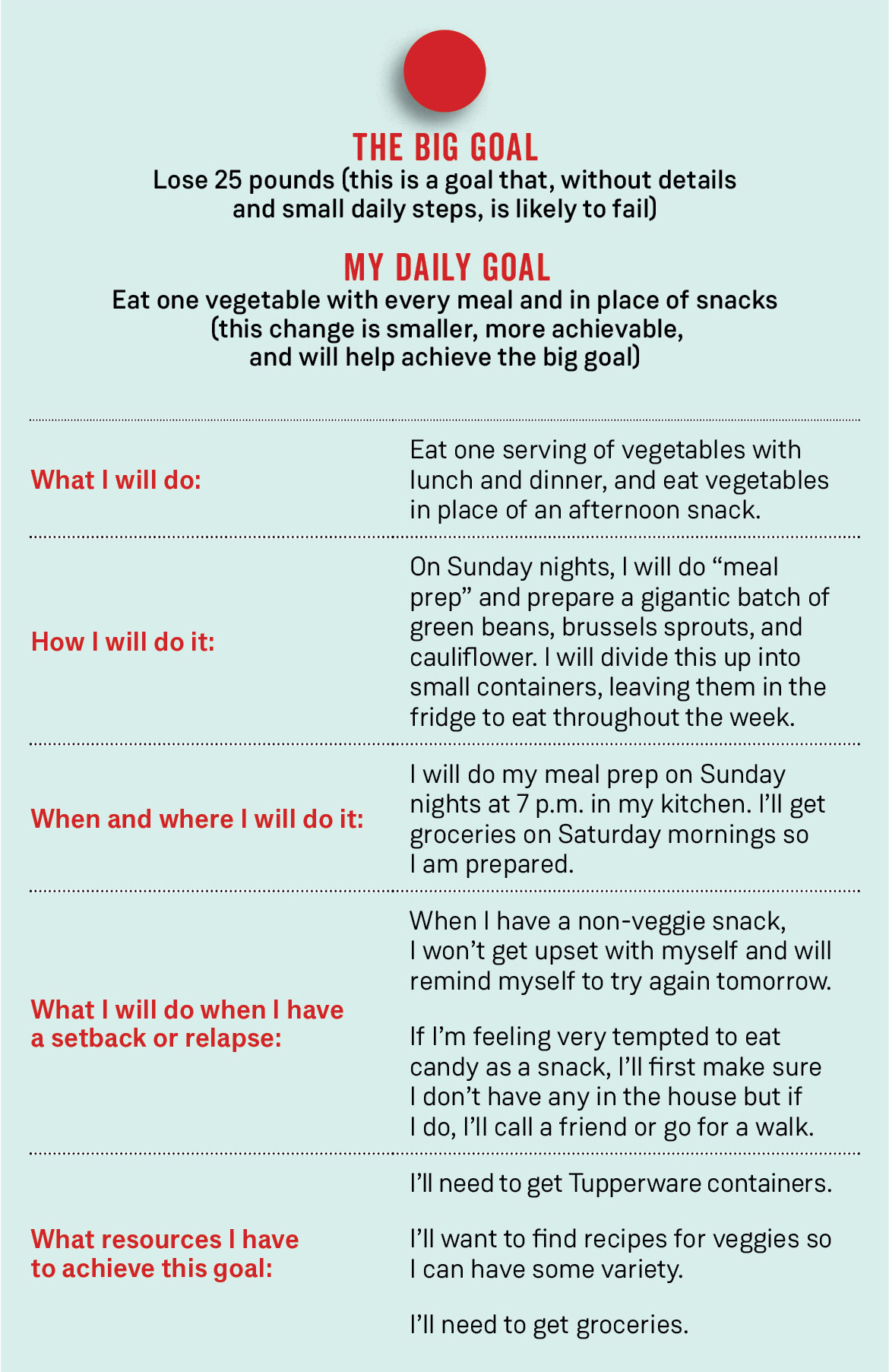The start of a new year is often a time of reflection and resolutions. Subsequently, we are bombarded with advertisements for diet plans, gyms, and smoking cessation products, setting people up with the expectation of making major changes to their lives. The reality is that, according to research from the University of Scranton, only 8% of people achieve their new year’s resolutions; most people abandon their desired changes by January 19.
One reason for not achieving health goals is that we attempt changes that are too ambitious. We want to lose 100 pounds or never smoke a cigarette again. While the goal itself is fine, we have not planned for the daily actions that it will take to achieve that goal.
This year, don’t make a dramatic new year’s resolution. Instead, resolve to make a small daily change to your health habits to make changes that will truly stick and last all year.
Once you have identified the expected outcomes and the risks of not changing behavior, it’s time to set a small, achievable plan for behavior change.
One way to make a health behavior change is to create an action plan. First, imagine the outcomes you expect as a result of changing your health behaviors. These can be both negative and positive. For example, if you resolve to exercise for 30 minutes each day, the expected outcomes might be that you will feel less stress, and sleep better, but also that you might have some muscle soreness or joint pain. These potential outcome expectations can be identified through an if/then statement—If I do “X”, then I will have “Y”. If/then statements for a new exercise routine might look like this:
- If I exercise for 30 minutes per day, then I will be able to sleep better at night.
- If I exercise for 30 minutes per day, then I might have to give up spending 30 minutes with my friends.
When setting goals for changing your health behavior, it is also important to think of the risks of not changing your habits. For example, the risk of not quitting smoking is a greater likelihood of getting cancer. Or the risk of not exercising is more difficulty managing blood sugars, which can create major health issues for people who are diabetic.
Once you have identified the expected outcomes and the risks of not changing behavior, it’s time to set a small, achievable plan for behavior change.
The table shown below is a template for outlining the steps to changing behavior. In this example, the goal is to lose weight and eat a healthier diet.
As you think about changing your health habits, here are recent guidelines to give you potential goals to work towards.
Physical activity
The goal for adults over the age of 18 is to achieve at least 150 minutes (two and a half hours) of moderate-intensity aerobic activity, like biking, brisk walking/jogging, or fast dancing. If you are not reaching 150 minutes each week right now, that’s okay! Start where you’re at and add seven to 15 minutes more time each week. Adults also need muscle-strengthening activity, such as lifting weights or doing push-ups, at least twice a week. Most importantly, find activities that you enjoy and that are accessible. There is good evidence that people will stick to physical activities they enjoy compared to those they don’t. One of the most accessible ways to get physical activity is in your own home. There are a variety of Zoom-based exercise classes available through senior centers and YouTube. Thanks to a grant from the Administration for Community Living, there are also free Zoom exercise classes for people living with HIV through CJE SeniorLife in Chicago. To learn more about these classes, you can email Margaret.Danilovich@cje.net.
Nutrition
One of the challenges with HIV is body changes from lipodystrophy (fat distribution syndrome), as well as medication side effects that can cause weight changes, increased cholesterol, fatigue, and muscle wasting. Nutritional principles for people living with HIV include eating a diet higher in fruits and vegetables (5–6 servings per day), whole grains, and lean proteins. Because of the muscle wasting that can occur in HIV, the protein recommendation is to aim for 100–150 grams per day for men and 80–100 grams per day for women. It is key to optimize vitamin and mineral intake especially with HIV because of the boost they provide to the immune system. One general recommendation is to “eat the rainbow”—consume a colorful variety of fruits and vegetables every day to get the full range of vitamins and minerals.
To make 2022 the healthiest year possible, set small, daily goals to improve your health. Make a detailed plan for how you will achieve your goals. And no matter the setbacks, remind yourself that tomorrow is a brand new day to begin again on your way to positive daily health habits.
Margaret Danilovich is the senior director of the Leonard Schanfield Research Institute at CJE SeniorLife and an adjunct assistant professor at Northwestern University, where she directs the dual degree Master of Public Health and Doctor of Physical Therapy program. A physical therapist by background, she has practiced her entire career with older adults. Her current research has been funded by the NIH, Retirement Research Foundation, and Third Coast Center for AIDS Research and focuses on exercise interventions for older adults with frailty.



